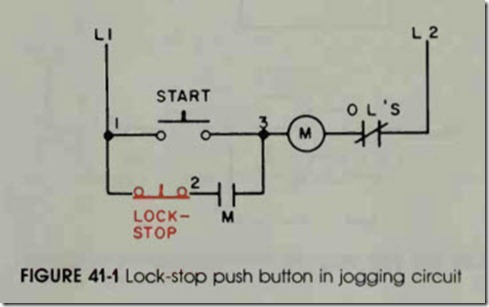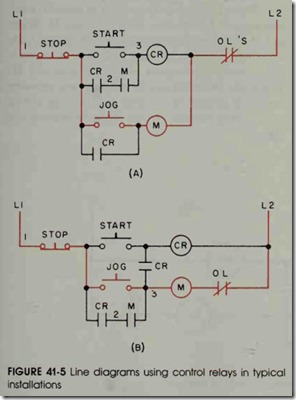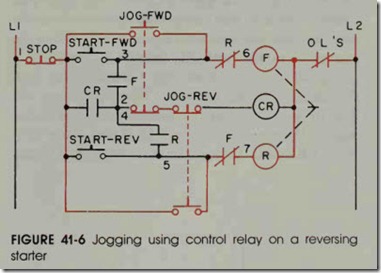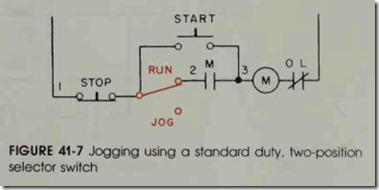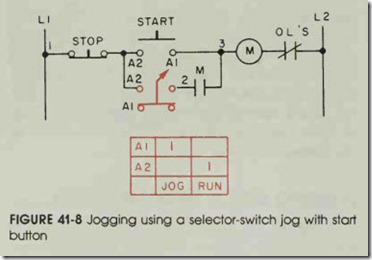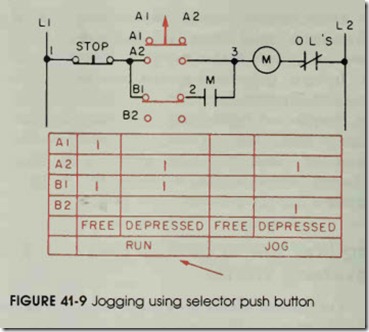Objectives
After studying this unit, the student will be able to:
• Define the process of jogging control
• State the purpose of jogging controllers
• Describe the operation of a jogging control circuit using a control relay
• Describe the operation of a jogging control using a control relay on a reversing starter
• Describe the operation of a jogging control using a selector switch
• Connect jogging controllers and circuits
• Recommend solutions for troubleshooting jogging controllers
Jogging, or inching, is defined by the Na tional Electrical Manufacturers’ Association (NEMA) as “the quickly repeated closure of a cir cuit to start a motor from rest for the purpose of accomplishing small movements of the driven ma chine.” The term jogging is often used when refer ring to across-the-line starters; the term inching can be used to refer to reduced voltage starters. Generally, the terms are used interchangeably be cause they both prevent a holding circuit.
JOGGING CONTROL CIRCUITS
The control circuits covered in this unit are representative of the various methods that are used to obtain jogging.
Figure 41-1 is a line diagram of a very simple jogging control circuit. The stop button is held open mechanically, figure 41-2. With the stop button held open, maintaining contact M cannot hold the coil energized after the start button is closed. The disadvantage of a circuit connected in this manner is the loss of the lock-stop safety feature. This circuit can be mistaken for a conventional three-wire control circuit, locked off for safety rea sons, such as to keep a circuit or machine from being energized. A padlock should be installed for safety purposes.
If the lock-stop push button is used for jog ging, it should be clearly marked for this purpose.
Figure 41-3 illustrates other simple schemes for jogging circuits. The normally closed push button contacts on the jog button in figure 41-3(B) are connected in series with the holding circuit contact on the magnetic starter. When the jog but ton is pressed, the normally open contacts ener gize the starter magnet. At the same time, the nor mally closed contacts disconnect the holding circuit. When the button is released, therefore, the starter immediately opens to disconnect the motor from the line. The action is similar in figure 41-3(A). A jogging attachment can be used to prevent the reclosing of the normally closed contacts of the jog button. This device assures that the starter holding circuit is not re-established if the jog button is re leased too rapidly. Jogging can be repeated by re closing the jog button; it can be continued until the jogging attachment is removed.
If the circuits shown in figure 41-3 are used without the jogging attachment men tioned, they are hazardous. A control station using such a circuit, less a jogging attachment, can maintain the circuit when the operator’s finger is quickly removed from the button. This could in jure production workers, equipment, and ma chinery. This circuit should not be used by re sponsible people committed to safety in the electrical industry.
JOGGING USING A CONTROL RELAY
When a jogging circuit is used, the starter can be energized only as long as the jog button is de pressed. This means the machine operator has in stantaneous control of the motor drive.
The addition of a control relay to a jogging circuit provides even greater control of the motor drive. A control relay jogging circuit is shown in figure 41-4. When the start button is pressed, the control relay is energized and a holding circuit is formed for the control relay and the starter mag net. The motor will now run. The jog button is connected to form a circuit to the starter magnet. This circuit is independent of the control relay. As a result, the jog button can be pressed to obtain the jogging or inching action.
Other typical jogging circuits using control relays are shown in figure 41-5. In figure 41-S(A), pressing the start button energizes the control re lay. In turn, the relay energizes the starter coil. The normally open starter interlock and relay con tact then form a holding circuit around the start button. When the jog button is pressed, the starter coil is energized independently of the relay and a holding circuit does not form. As a result, a jogging action can be obtained.
Jogging With a Control Relay on a Reversing Starter
The control circuit shown in figure 41-6 per mits the motor to be jogged in either the forward or the reverse direction while the motor is at standstill or is rotating in either direction. Press ing either the tart-forward button or the start-re verse button causes the corresponding starter coil to be energized. The coil then closes the circuit to the control relay which picks up and completes the holding circuit around the start button. While the relay is energized, either the forward or the reverse starter will also remain energized. If either jog button is pressed, the relay is de-energized and the closed starter is released. Continued pressing of either jog button results in a jogging action in the desired direction.
Jogging with a Selector Switch
The use of a selector switch in the control cir cuit to obtain jogging requires a three-element control station with start and stop controls and a selector switch. A standard duty, two-position se lector switch is shown connected in the circuit in figure 41-7. The starter maintaining circuit is dis connected when the selector switch is placed in the jog position. The motor is then inched with the start button. Figure 41-8 is the same circuit as that shown in figure 41-7 with the substitution of a heavy-duty, two-position selector switch.
The use of a selector push button to obtain jogging is shown in figure 41-9. In the jog posi tion, the holding circuit is broken, and jogging is accomplished by depressing the push button.
Jogging with a Push-Pull Operator
Another type of jog-run control can be con nected using a push-pull operator. The push-pull operator used in this circuit contains tw normally open momentary contacts, figure 41-10. When the control is pulled outward, contact A completes a circuit to coil CR. When coil CR energizes, both CR contacts close. Contact CR1 completes a cir cuit to the coil of motor starter M. When motor starter M energizes, contact M closes. Since con tacts CR2 and M are closed, a circuit is maintained to coil M when the push-pull operator is released and movable contact A returns to its nor mally open position. The circuit will remain in this condition until the stop button is pushed and coils CR and M de-energize.
When the push-pull operator is pressed, mov able contact B completes a circuit to coil M. When coil M energizes, auxiliary contact M closes. Con tact CR2, however, is open and there is no com plete circuit to maintain current flow to coil M. When the push button is released and movable contact B returns to its open position, the circuit to coil M is broken and the motor starter de-en ergizes.
REVIEW QUESTIONS
1. Why is jogging (inching) included in this section on “Methods of Deceleration”?
2. What is the safety feature of a lock-stop push button?
3. In (A) of figure 41-3, what will happen if both the run and jog push buttons are closed?
4. What will happen if the start and jog push buttons of the circuit shown in
figure 41-4 are pushed at the same time?
5. In figure 41-6, what will happen if both jog push buttons are pushed momentarily?
6. Draw an elementary control diagram of a reversing starter. Use a standard duty selector switch with forward, reverse, and stop push buttons with three methods of interlocking.
7. Describe the contact arrangement of the push-pull operator used for a jog-run control.
